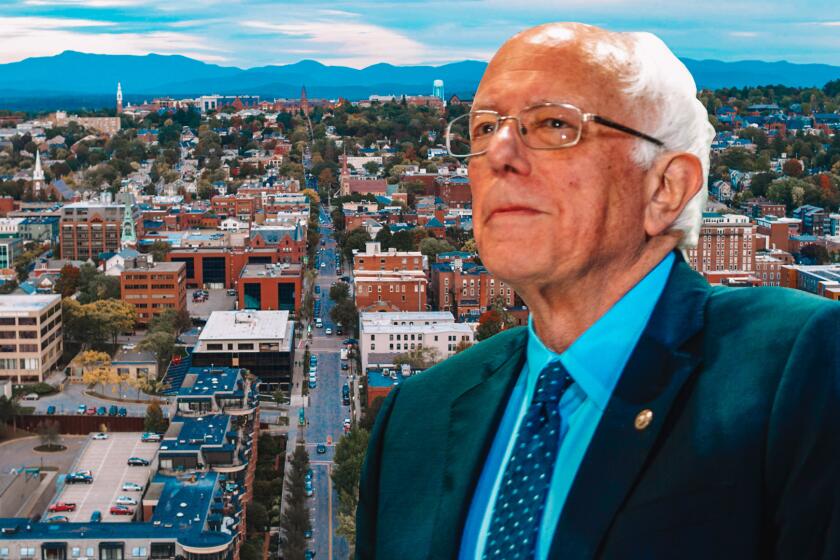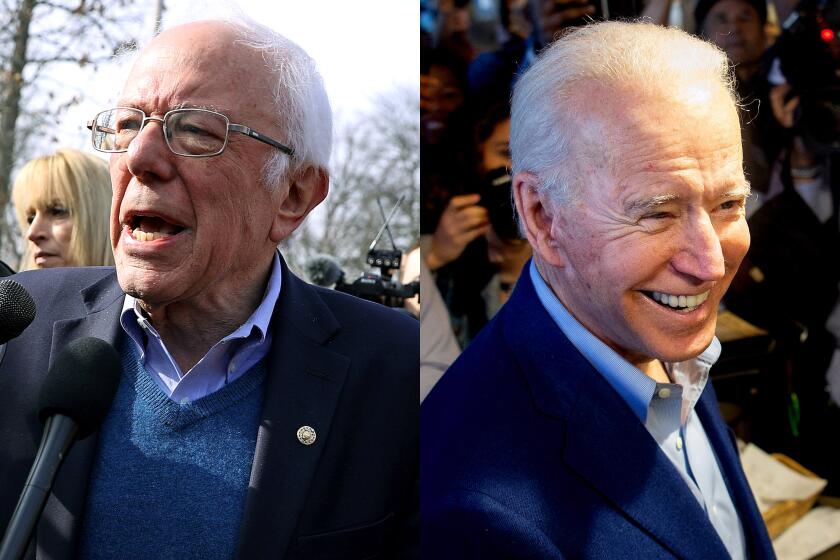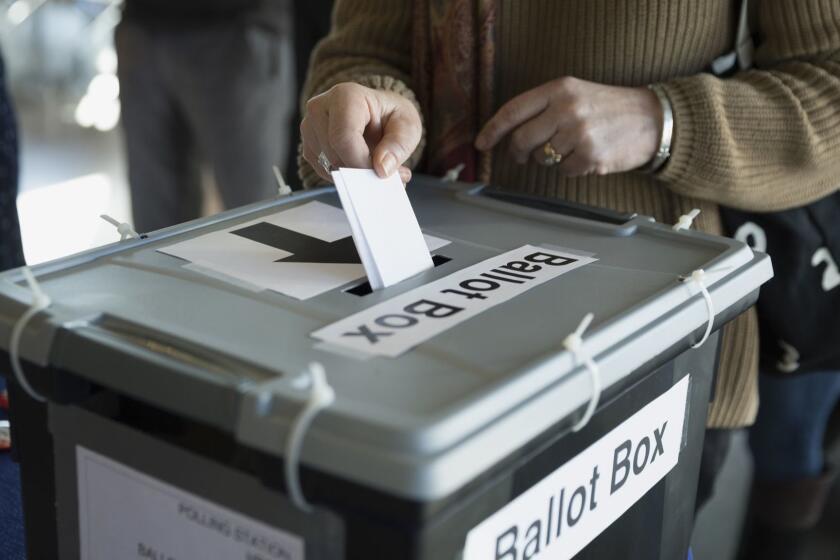Bernie Sanders grabs lead in California presidential primary poll
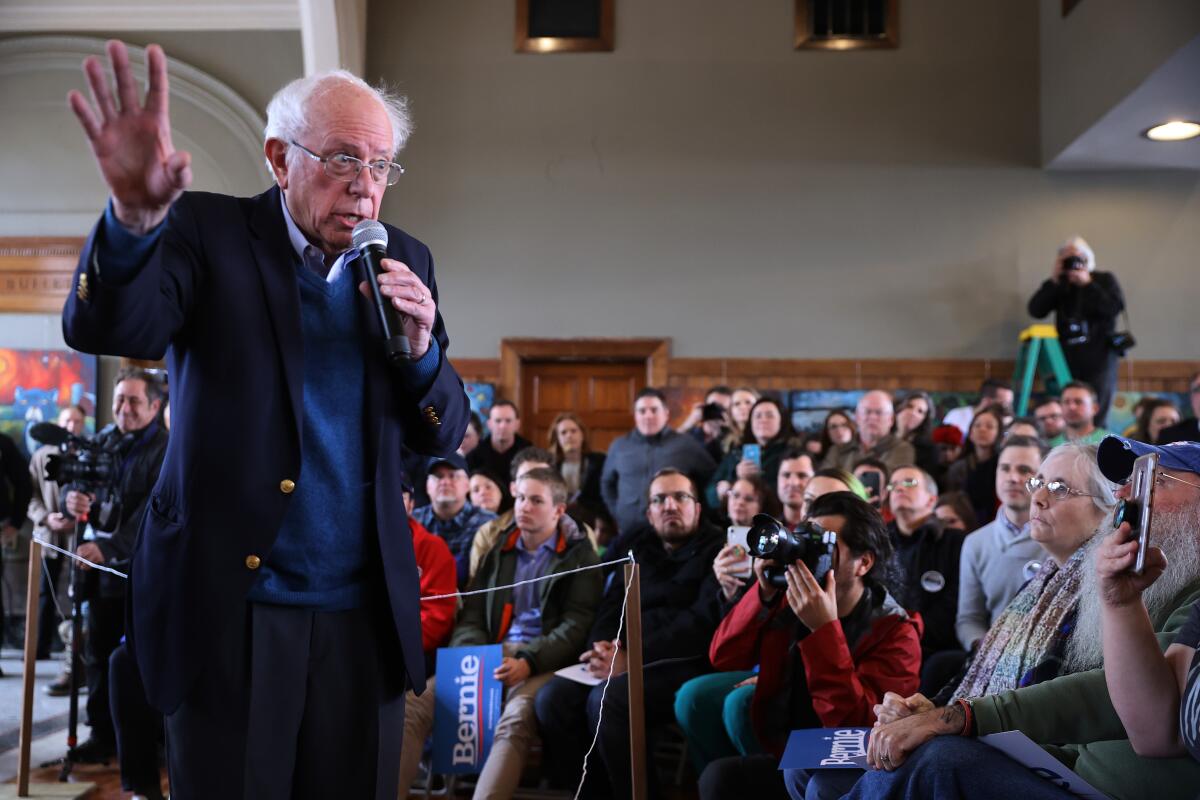
- Share via
WASHINGTON — Sen. Bernie Sanders, consolidating support from voters on the left, has taken a clear lead in the race for California’s huge trove of Democratic convention delegates as the presidential campaign moves toward a critical month of primary contests.
Sanders has been propelled to the top in California by growing support from voters who label themselves “very liberal” — a shift that has come largely at the expense of Sen. Elizabeth Warren. That very liberal group makes up about one in three Democratic primary voters in the state.
Along with strong backing among Latinos and young voters, backing on the left is enough to give the Vermont senator support from 26% of voters likely to take part in the state’s March 3 Democratic primary, according to the latest UC Berkeley Institute of Governmental Studies poll, conducted for the Los Angeles Times. His gains in the state come as several polls in Iowa and New Hampshire — the states with the first contests of the primary season — also show Sanders gaining ground.
When the poll last surveyed California voters, in late November, Sanders and Warren were bunched tightly together. Since then, however, he has gained and she has continued to lose ground. The Massachusetts senator now has the support of 20% of likely voters, down from 22% in November and 29% in September.

By contrast to the consolidation on the left, the rest of the state’s likely primary voters remain divided among several candidates.
That has hampered former Vice President Joe Biden. He remains the front-runner nationally, but in third place in California, with 15% in the poll.
“California’s primary electorate is relatively liberal,” said Berkeley political science professor Eric Schickler, co-director of the institute. “The state is more conducive to one of the candidates on the left.”
Biden narrowly trails Sanders among voters who call themselves somewhat liberal, moderate or conservative, but runs 33 points behind him among the very liberal.
Sanders, Warren and Biden are the only candidates with enough support currently to win any of the state’s delegates to the Democratic nominating convention this summer.
Burlington shaped Sanders as Sanders shaped Burlington, so much so that it’s hard to consider one without the other.
Under state Democratic Party’s rules, delegates go to candidates who get at least 15% of the vote statewide or in a congressional district. The rest of the Democratic field remains far below that threshold, in single digits.
That includes former New York Mayor Michael R. Bloomberg, who already has spent more than $30 million advertising on the state’s airwaves, according to data compiled by Advertising Analytics, an ad tracking firm. That’s almost twice as much as the combined total that Sanders, Warren and Biden have spent nationwide on ads.
His enormous barrage has helped Bloomberg get to 6% in the poll, up from 2% in November. He shares the second tier of candidates with former mayor Pete Buttigieg of South Bend, Ind., at 7%, Sen. Amy Klobuchar of Minnesota at 5% and Andrew Yang, the technology entrepreneur, at 4%.
Another billionaire candidate, Californian Tom Steyer, lags behind at 2%. He has concentrated his spending on states that vote in February.
Despite his third-place position, Biden has a point of strength in the poll: He remains the candidate the state’s voters are most likely to say would beat President Trump. About a third of likely primary voters say so. Sanders comes in second on that score with about a quarter of voters — mostly his own supporters — calling him the one with the best chance of beating Trump in November.
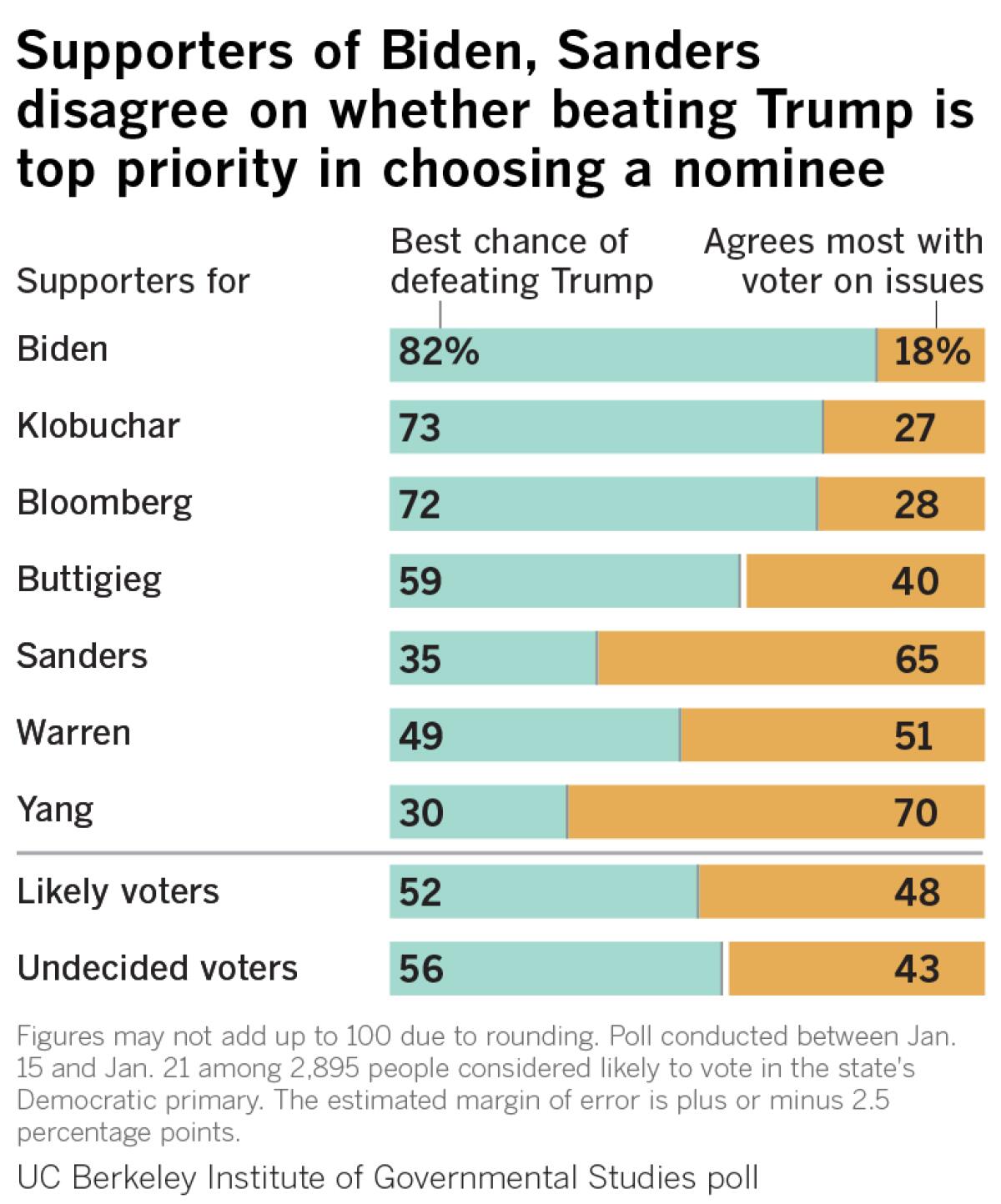
That question of electability has dominated the debate in Iowa, which votes in caucuses on Monday, and in New Hampshire, which holds its primary Feb. 11. In California, the issue of how much of a priority to put on picking an electoral winner sharply divides voters.
Overall, 53% of likely voters give priority to picking the candidate most likely to win; 47% go with the candidate who agrees with them on the issues.
Registered Democrats call picking a candidate who will win in November their top priority. Voters who don’t register with a party but plan to vote in the primary lean toward a candidate who agrees with them on issues by 57%-43%. Non-party voters are able to take part in California’s Democratic primary, although not in the Republican primary.
Voters younger than 30, who heavily back Sanders, overwhelmingly favor a candidate who agrees with them on issues, 80%-20%, while voters 65 and older, who tend to back Biden, say by 72%-28% that picking the most likely November winner takes priority.
About two-thirds of Sanders’ supporters put priority on a candidate who agrees with them on issues. Biden supporters go the other way, with 82% giving priority to choosing a nominee with the best chance of winning. Warren’s supporters divide evenly.
Backers of Biden, Sanders and Bloomberg each say their man is the most electable, but supporters of some of the other candidates aren’t so sure. Warren and Klobuchar voters divide on whether their favored candidate or Biden is the more electable. Buttigieg’s followers give the edge to Biden.
The emphasis that Sanders’ backers put on issues gives him a strong position. A question mark for him is whether anything happens between now and the primary that might dampen turnout. Sanders’ lead relies heavily on groups who don’t always show up to cast ballots, including voters younger than 30 — 54% of whom favor Sanders — and Latinos, among whom he leads Biden 38%-18%.
Biden leads among some groups that tend to routinely vote, such as voters 65 and older. He has support from 22% of them, compared with 16% for Warren and 14% for Sanders.
Warren’s biggest source of strength continues to be the most-educated voters, who also tend to have high turnout. She gets support from 26% of those with a post-graduate education, who make up about a quarter of the primary electorate in the state — compared with 17% for Sanders and 14% for Biden.
“The generational clash in voting preferences between Sanders and Biden is perhaps even more striking than the party’s tug-of-war between its liberals and conservatives,” said Mark DiCamillo, the veteran pollster who oversees the Berkeley IGS survey.
“Sanders’ support among younger voters has been steadily growing over time. Because of this, turnout will be extraordinarily influential in determining the outcome.”
After a year-long campaign, voters have a fairly clear sense of the ideologies of the candidates. Asked to rate their own political beliefs and those of the candidates on a scale from 1 to 10, with 1 being the most conservative, likely primary voters place themselves left of center, with an average of 7.2.
Voters rank Sanders and Warren fairly close together and to their left, with Sanders at 8.8 and Warren 8.0. Voters on average view the other candidates as clustering somewhat to their right, with Yang at 6.9, Buttigieg 6.1, Klobuchar 5.7, Biden 5.4 and Bloomberg considered the most conservative, at 5.2.
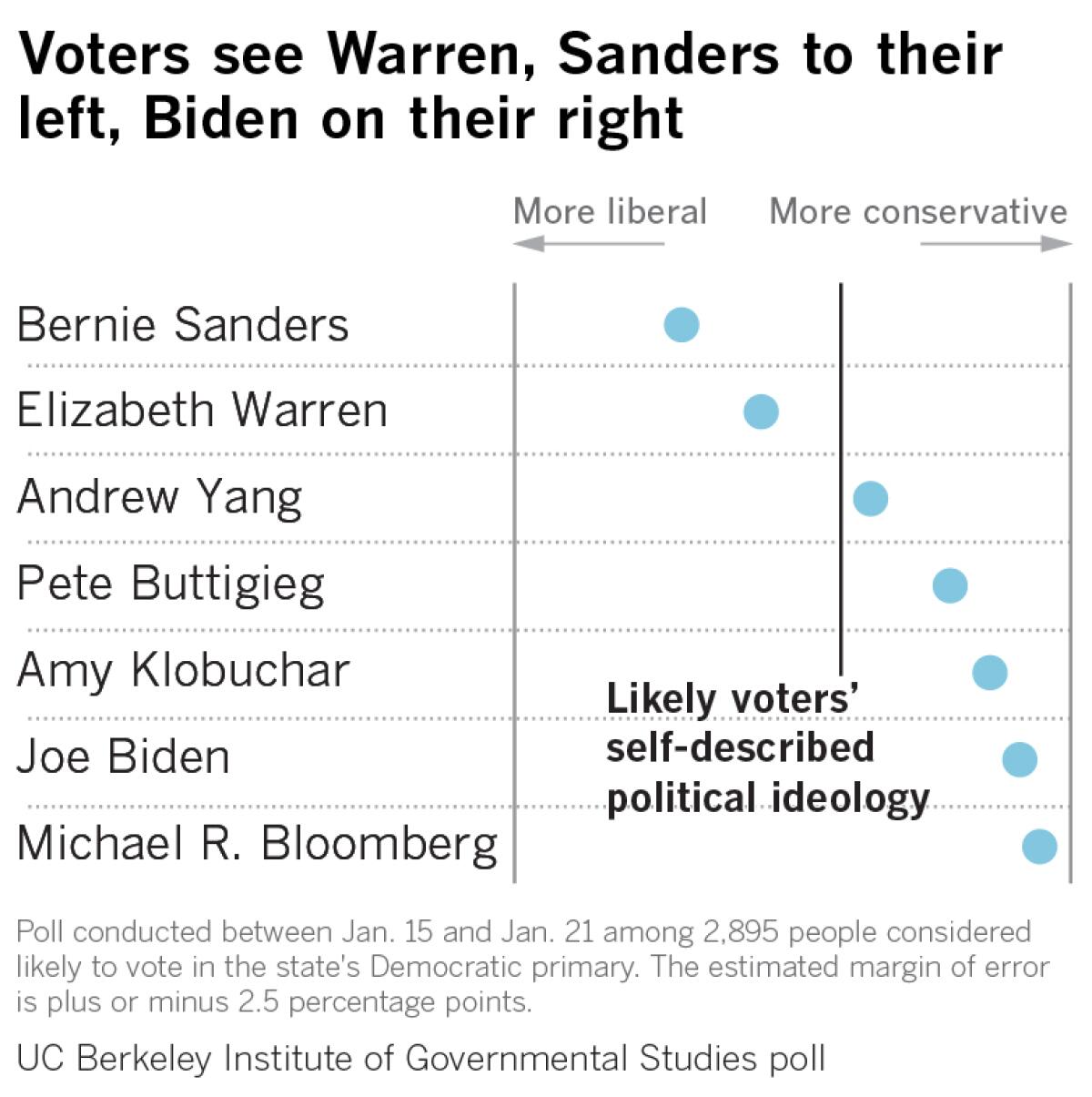
The poll asked that same question in September, and the rankings of most candidates have changed very little. The main exception is that voter perceptions of Buttigieg have shifted somewhat to the right as he has positioned himself as a moderate alternative to Sanders and Warren.
The gap between how voters perceive the two candidates on the left and the group of four to the right is fairly large, said Schickler.
“The concrete policy differences are not that vast, certainly not in terms of what a Democratic president would be able to accomplish,” he said. “The fact that people perceive such a big gulf could be a problem for the party” in trying to unite after the nomination fight ends.
Potentially, Biden could gain ground over the next five weeks by picking up backers of other moderates. That may not be easy, however.
Only about 1 in 5 supporters of Klobuchar and Buttigieg, for example, listed Biden as their second choice. And support for Bloomberg shows signs of continuing to rise: His standing appeared to improve slightly over the course of the week that the poll was in the field.
California’s March 3 primary will allocate 416 of the state’s 495 convention delegates, by far the largest group from any state. The rest are elected officials and others who attend as unpledged so-called super-delegates.
In addition to California, 13 other states will hold contests on March 3. In all, about 40% of the delegates to the nominating convention will be allocated that day.
Here are key dates and events on the the 2020 presidential election calendar, including dates of debates, caucuses, primaries and conventions.
The state’s rules — distributing delegates partly on a statewide basis and partly by individual congressional districts — give an advantage to a candidate like Sanders whose support statewide is well above 15% because he is likely to hit the threshold in all 53 congressional districts.
A candidate like Biden, who is just at the threshold statewide, likely will cross the bar for winning delegates in some districts, but not others.
The large number of voters surveyed by the Berkeley IGS poll allows some analysis of that. None of the major candidates do strikingly better in some parts of the state than others, the poll found. Sanders currently appears likely to cross the 15% threshold in nearly all the state’s congressional districts, while Biden would do so in only about half of them. Warren would get delegates in more congressional districts than Biden, but fewer than Sanders.
The UC Berkeley Institute of Governmental Studies poll that The Times is publishing uses a method that differs from traditional phone-based surveys.
The UC Berkeley IGS poll was conducted online in English and Spanish, Jan. 15-21, among 6,845 registered voters statewide, including 2,895 considered likely to take part in the state’s Democratic presidential primary. The estimated margin of error for the Democratic sample is roughly 2.5 percentage points in either direction. Full text of the questions asked and details on the methodology are available on the Berkeley IGS website.
More to Read
Get the L.A. Times Politics newsletter
Deeply reported insights into legislation, politics and policy from Sacramento, Washington and beyond. In your inbox three times per week.
You may occasionally receive promotional content from the Los Angeles Times.
